Related Research Articles
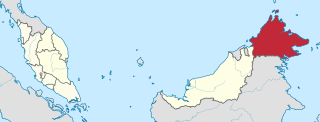
Sabah is a state of Malaysia located on the northern portion of Borneo, in the region of East Malaysia. Sabah has land borders with the Malaysian state of Sarawak to the southwest and Indonesia's North Kalimantan province to the south. The Federal Territory of Labuan is an island just off Sabah's west coast. Sabah shares maritime borders with Vietnam to the west and the Philippines to the north and east. Kota Kinabalu is the state capital and the economic centre of the state, and the seat of the Sabah State government. Other major towns in Sabah include Sandakan and Tawau. The 2020 census recorded a population of 3,418,785 in the state. It has an equatorial climate with tropical rainforests, abundant with animal and plant species. The state has long mountain ranges on the west side which forms part of the Crocker Range National Park. Kinabatangan River, the second longest river in Malaysia runs through Sabah. The highest point of Sabah, Mount Kinabalu is also the highest point of Malaysia.

Tawi-Tawi, officially the Province of Tawi-Tawi, is an island province in the Philippines located in the Bangsamoro Autonomous Region in Muslim Mindanao (BARMM). The capital of Tawi-Tawi is Bongao.

The Tausūg, are an ethnic group of the Philippines and Malaysia. A small population can also be found in the northern part of North Kalimantan, Indonesia. The Tausūg are part of the wider political identity of Muslim Filipinos of western Mindanao, the Sulu archipelago, and southern Palawan, collectively referred to as the Moro people. The Tausugs originally had an independent state known as the Sultanate of Sulu, which once exercised sovereignty over the present day provinces of Basilan, Palawan, Sulu, Tawi-Tawi, Zamboanga City, North Kalimantan and the eastern part of the Malaysian state of Sabah. They are also known in the Malay language as Suluk.

Sandakan formerly known at various times as Elopura, is the capital of the Sandakan District in Sabah, Malaysia. It is the second largest city in Sabah after Kota Kinabalu. It is located on the Sandakan Peninsula and east coast of the state in the administrative centre of Sandakan Division and was the former capital of British North Borneo. In 2010, the city had an estimated population of 157,330 while the overall municipal area had a total population of 396,290. The population of the municipal area had increased to 439,050 by the 2020 Census.

Sitangkai, officially the Municipality of Sitangkai, is a 1st class municipality in the province of Tawi-Tawi, Philippines. According to the 2020 census, it has a population of 37,319 people.

The Sama-Bajau include several Austronesian ethnic groups of Maritime Southeast Asia. The name collectively refers to related people who usually call themselves the Sama or Samah ; or are known by the exonym Bajau. They usually live a seaborne lifestyle and use small wooden sailing vessels such as the perahu, djenging (balutu), lepa, and vinta (pilang). Some Sama-Bajau groups native to Sabah are also known for their traditional horse culture.

The North Borneo dispute, also known as the Sabah dispute, is the territorial dispute between Malaysia and the Philippines over much of the eastern part of the state of Sabah. Sabah was previously known as North Borneo prior to the formation of the Malaysian federation.
Illegal immigration to Malaysia is the cross-border movement of people to Malaysia under conditions where official authorisation is lacking, breached, expired, fraudulent, or irregular. The cross-border movement of workers has become well-established in Southeast Asia, with Malaysia a major labour-receiving country and Indonesia and the Philippines the region's main labour-sending states. Managing cross-border migration has become an issue of increasing concern in Malaysia and its international relations.
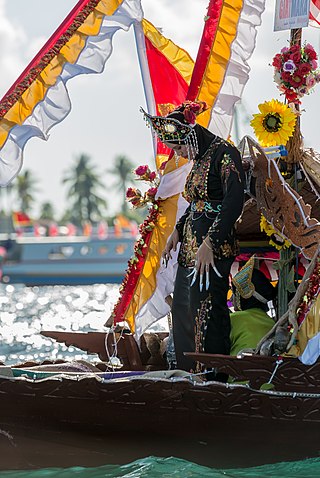
Pangalay is the traditional "fingernail" dance of the Tausūg people of the Sulu Archipelago and eastern coast Bajau of Sabah.
Jamalul ibni Punjungan Kiram III was a former self-proclaimed Sultan of the Sulu Sultanate who claimed to be "the poorest sultan in the world". He was known as an unsuccessful candidate for senator in the Philippine general elections in 2007. In 2013, Kiram III sparked a controversy when he revived a dispute between the Philippines and Malaysia by leading an intrusion into the eastern part of Sabah. His daughter is Princess Jacel Kiram, a proponent of the Sabah claim of the Philippines in 2016.
Project IC is the name used in Malaysia to describe the allegation of systematic granting of citizenship to immigrants by giving them identity cards and subsequently its current iteration, the MyKad. The alleged practice is centred in the state of Sabah in East Malaysia. The term is used mainly by the media as well as other political commentators and the general public. Another term used is Project M, the "M" referring to former prime minister Mahathir Mohamad due to his alleged involvement in the spearheading of the project.
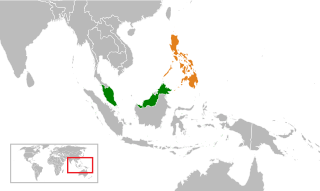
Malaysia–Philippines relations refers to the bilateral relations between Malaysia and the Philippines. The Philippines has an embassy in Kuala Lumpur, and Malaysia has an embassy in Manila and a consulate general in Davao City. The people of the two neighbouring countries have a long history of cultural and political relations.

The history of Sabah can be traced back to about 23–30,000 years ago when evidence suggests the earliest human settlement in the region existed. The history is interwoven with the history of Brunei and the history of Malaysia, which Sabah was previously part of and is currently part of respectively. The earliest recorded history of Sabah being part of any organised civilisation began in the early 15th century during the thriving era of the Sultanate of Brunei. Prior to this, early inhabitants of the land lived in predominantly tribal societies, although such tribal societies had continued to exist until the 1900s. The eastern part of Sabah was ceded to the Sultan of Sulu by the Sultan of Brunei in 1658 for the former helping a victory over Brunei enemies, but many sources stated it had not been ceded at all. By the late 19th century, both territories previously owned by Sultan of Brunei and Sultan of Sulu was granted to British syndicate and later emerged as British North Borneo under the management of the North Borneo Chartered Company. Sabah became a protectorate of the United Kingdom in 1888 and subsequently became a Crown colony from 1946 until 1963, during which time it was known as Crown Colony of North Borneo. On 16 September 1963, Sabah merged with Malaya, Sarawak and Singapore to form Malaysia.
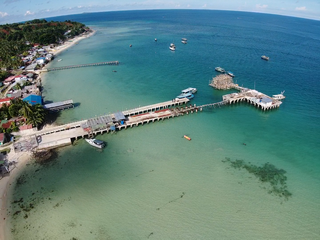
Taganak Island is a small tropical island surrounded by the Sulu Sea in the province of Tawi-Tawi, Philippines. The island is the largest of the seven Philippine Turtle Islands.

The 2013 Lahad Datu standoff, also known as the Lahad Datu incursion or Operation Daulat, was a military conflict in Lahad Datu, Malaysia. The conflict began on 11 February, when 235 militants arrived in Lahad Datu by boat, and ended on 24 March. The militants, self proclaimed as "Royal Security Forces of the Sultanate of Sulu and North Borneo", were sent by a claimant to the throne of the Sultanate of Sulu.
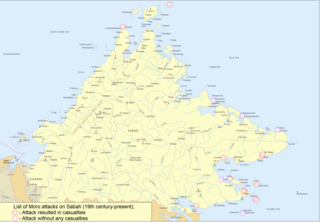
The cross border attacks in Sabah are a series of cross border terrorist attacks perpetrated by Moro pirates from Mindanao, Philippines, in the state of Sabah, Malaysia, that began even before the British colonial period. Many civilians have died or suffered during these incidents, causing an increase in anti-Filipino sentiment among the native peoples of Sabah, especially after major attacks in 1985, 2000 and 2013. The attacks were more intense during the presidential terms of Diosdado Macapagal and Ferdinand Marcos, who supported irredentist claims to include eastern Sabah as part of the Philippines territory. In addition, recent infiltration and attacks by militants as well as uncontrolled human migration from Mindanao to Sabah has led to more unease sentiments among the local residents of Sabah, with around 78% of prison inmates that were caught in the state due to involvement in criminal activities and lawlessness issues mainly originating from the southern Philippines.

Filipino refugees are persons originating from the country of the Philippines. Following the Moro conflict and subsequent major military operation in the islands of Mindanao during the administration of President Ferdinand Marcos in 1970s, thousands of Filipinos mainly from the Moro ancestry have sought refuge in neighbouring countries of Malaysia, Indonesia and Brunei, with majority of them mostly heading to the state of Sabah in Malaysia.

Sabah is the third most populous state in Malaysia, with a population of 3,418,785 according to the 2020 Malaysian census. It also has the highest non-citizen population, at 810,443. Although Malaysia is one of the least densely populated countries in Asia, Sabah is particularly sparsely populated. Most of the population is concentrated along coastal areas, with towns and urban centers seeing the most population growth.

The Lahad Datu District is an administrative district in the Malaysian state of Sabah, part of the Tawau Division which includes the districts of Kunak, Lahad Datu, Semporna and Tawau. The capital of the district is in Lahad Datu Town.

Sitangkai Island is an island located in the province of Tawi-Tawi, Philippines. It is part of the chain of islands that are found in between the islands of Borneo and Mindanao, called the Sulu Archipelago. The town center or the urban area of the municipality of Sitangkai is concentrated on the island. The island is divided and locally administered by the barangays of Sitangkai Poblacion and Panglima Alari. Most of the residents engage in trading, seaweeds farming and fishing. With an estimated population of 12,151 and with an area of around 0.3 km2, Sitangkai Island is one of the most densely populated islands in the country.
References
- 1 2 Uy, Vernoica (6 February 2009). "No foreign workers' layoffs in Malaysia". Global Enquirer. Archived from the original on 9 February 2009. Retrieved 16 February 2009.
- ↑ "Filipino workers in Malaysia". Philippines: Office of the Press Secretary. 2003. Archived from the original on 23 April 2009. Retrieved 19 November 2008.
- ↑ "Kababayan community holds first gathering in Sabah". The Borneo Post. 28 September 2015. Retrieved 10 October 2015.
- ↑ Department of Foreign Affairs, Philippine Overseas Employment Administration, Commission on Filipinos Overseas
- ↑ Hunt, Luke (27 November 2008). "Malaysia's Deportation of Filipino Refugees Raises Concerns". World Politics Review. Archived from the original on 5 December 2008. Retrieved 16 February 2009.
- 1 2 "300 illegal Pinoys deported from Malaysia". ABS-CBN News. 17 February 2009. Retrieved 17 February 2009.
- ↑ ""Home is where greener pasture is," DSWD tells illegal Filipinos in Sabah". Philippine Information Agency. 16 May 2007. Retrieved 16 February 2009.
- ↑ "Useful Information for Filipinos in Malaysia". phil.embassy.kl. 10 July 2008. Retrieved 16 February 2009.
- ↑ "Undocumented Filipino migrants in Malaysia to be assisted". DOLE News. 1 February 2005. Archived from the original on 3 March 2016. Retrieved 16 February 2009.
- ↑ "Filipino's working abroad". Hogeschool Utecht. 2002. Retrieved 17 February 2009.
- ↑ Jacinto, Al (17 October 2005). "330 Filipinos home after being deported from Sabah". Manila Times. Retrieved 16 February 2009.
- ↑ "Foreigners make up 58% of Sabah prison inmates". Bernama. The Star. 19 March 2015. Retrieved 19 March 2015.
- ↑ Charlie Saceda (6 March 2013). "Pinoys in Sabah fear retaliation". Rappler. Archived from the original on 24 October 2015. Retrieved 7 March 2013.
- ↑ Fiqrie Dahari (4 February 2016). "Hairstylist to the stars turns his eye to photography". Star2.com. Retrieved 21 February 2019.
- ↑ Arfa Yunus (6 June 2013). "Andrea Fonseka - "I am looking forward for motherhood"". Astro Awani. Retrieved 21 February 2019.
- ↑ MOHD HAFIZ ISMAIL (30 January 2014). "Zamir juara MasterChef Malaysia All Stars" (in Malay). Karangkraf. Retrieved 21 February 2019.
- ↑ N. RAMA LOHAN, WONG LI ZA and SHEELA CHANDRAN (2015). "They're Malaysians, through and through". Star2.com. Retrieved 21 February 2019.
- ↑ WAHIDUZZAMAN (14 March 2010). "Iqbal Mazlan Teringin Berlakon Filem MIG dan TU" (in Malay). Mstar. Retrieved 21 February 2019.
- ↑ Amirah Amaly Syafaat (19 November 2017). "Kemenangan ini sangat bermaruah!" (in Malay). Utusan. Retrieved 21 February 2019.
- ↑ "Sabah's Scarlett in Miss Inter- continental Top 20". Daily Express. 30 January 2019. Retrieved 21 February 2019.
- ↑ David William Pelino, Robert Andrew Garcia and Reymark Begomia (30 August 2017). "Philippine Squash bets fall to Singapore in SEA Games". Astro Awani. Retrieved 21 February 2019.
- ↑ Mumtaj Begum (14 November 2018). "17-year-old Malaysian singer Yazmin Aziz juggles music and studies". Star2.com. Retrieved 21 February 2019.
